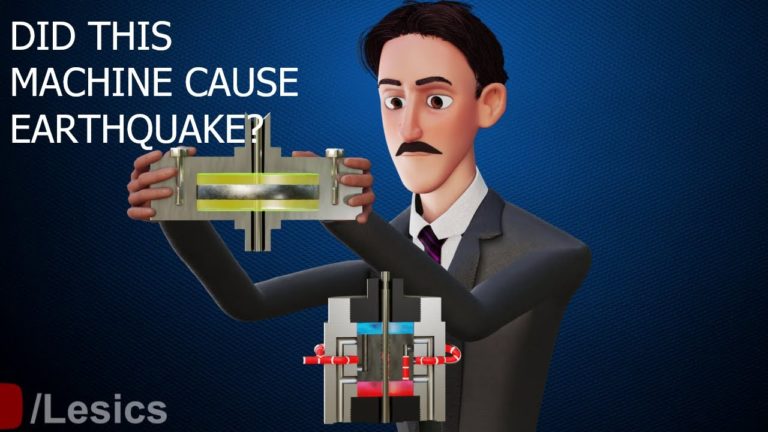Tesla’s Earthquake machine | The complete Physics behind it
Nikola Tesla is today famous for his work on electricity and energy. He developed the alternating current system, making it possible to transmit electricity over large distances, and worked also on wireless communication and energy transfer. He was a brilliant thinker, but also very eccentric. Maybe the more enigmatic parts of his personality make him such an interesting subject for conspiracists. Tesla is credited to have worked on unknown energy-sources, to be contacted by UFOs, caused the Tunguska explosion by a death-ray, and even worked on an earthquake-generator.
In 1896 Tesla was working on oscillations to be used for energy transfer. The idea was to create a steam-powered oscillator, able to create various frequencies. If the frequency matched the resonance frequency, a receiving device should transform the mechanical oscillations back into an electric current.
In 1897 the device was ready and in 1898 he supposedly managed to oscillate his laboratory at 48 E. Houston St., New York, enough, that alarmed neighbors called the police and ambulance, fearing an earthquake happening. Tesla later explained this principle to reporter Allan L. Besnson, who published in February 1912 an article about Tesla’s resonator in The World Today magazine:
“He put his little vibrator in his coat-pocket and went out to hunt a half-erected steel building. Down in the Wall Street district, he found one, ten stories of steel framework without a brick or a stone laid around it. He clamped the vibrator to one of the beams, and fussed with the adjustment until he got it.
Tesla said finally the structure began to creak and weave and the steel-workers came to the ground panic-stricken, believing that there had been an earthquake. Police was called out. Tesla put the vibrator in his pocket and went away. Ten minutes more and he could have laid the building in the street. And, with the same vibrator, he could have dropped the Brooklyn Bridge into the East River in less than an hour.”
Tesla imagined using the waves generated by his invention for peaceful applications. One device would transform electricity into vibrations. Tesla then would use the rocks in the underground to send the vibrations to a second device. This recieving device would pick up the vibrations and transform the oscillations into electricity, to be used locally. In fact, so Tesla, the device, consisting of a piston vibrating in a cylinder, was already powerful enough to vibrate an entire building. Just one precaution was necessary. If powerful enough, so Tesla, his machine could match Earth’s frequency, causing even earthquakes. Still, in the 1930s, Tesla imagined using smaller devices to relieve energy from Earth, in this case, to prevent earthquakes. However, the “telegeodynamics” system by Tesla never managed to get beyond the prototype. The device was in reality not powerful enough to send energy far enough. Dampening of the oscillations by structures and the underground was far too strong. Another idea of Tesla was more successful. He imagined using the oscillations generated by his device to prospect the underground. Waves send into the underground would be reflected by obstacles or different rocks. Observing the returning waves, a geologist may be able to see the underground. It’s just this basic idea that modern seismologists use. Pulses of energy, generated by electromagnetic devices, controlled explosions or mechanical pistons, send deep into the underground are reflected or deflected by geological structures. The reflected signals can then be used to reconstruct a model of the underground.
Nikola Tesla claimed that one machine he developed for producing constant frequency electricity caused earthquake in NewYork city. Is his claim true? Let’s explore the working of this beautiful piece of technology and also try to find out the truth behind his earthquake claim.
Do not forget to share your opinion with us to provide you with the best posts !




0 Comments